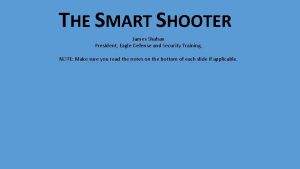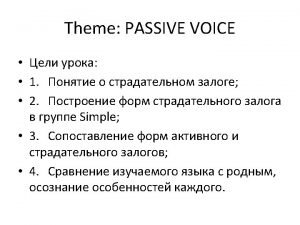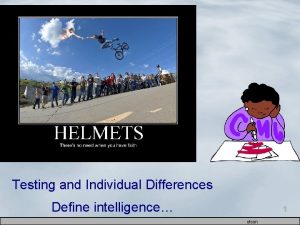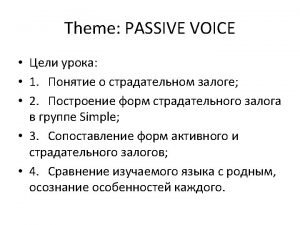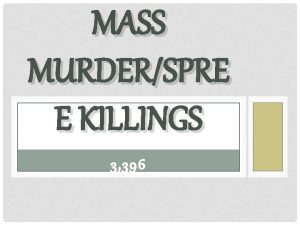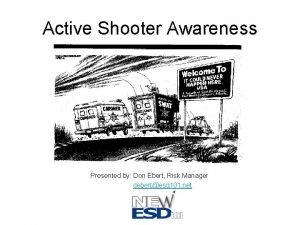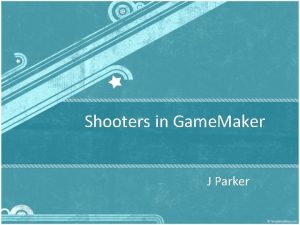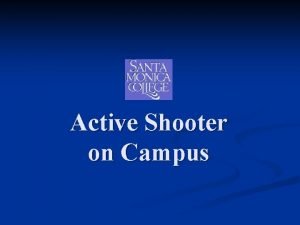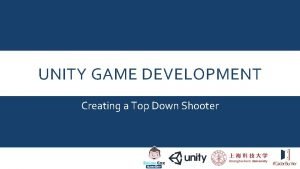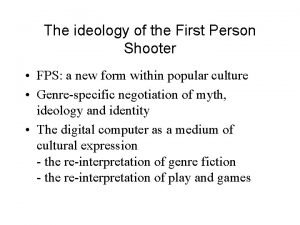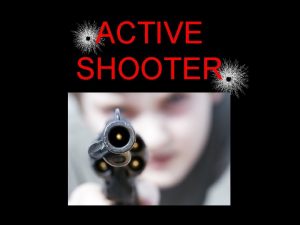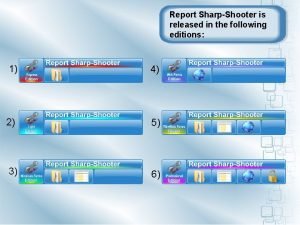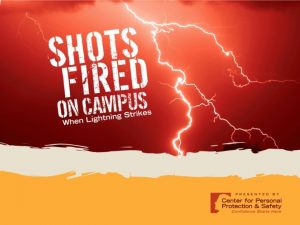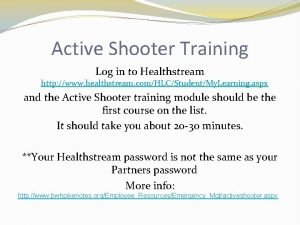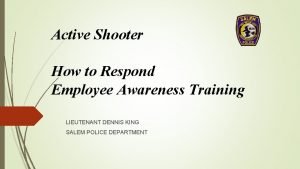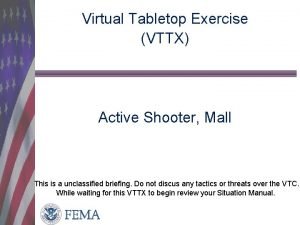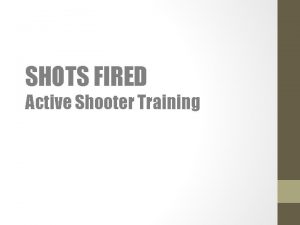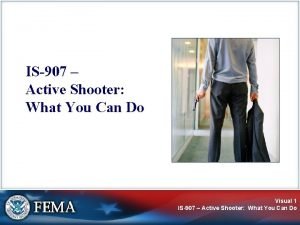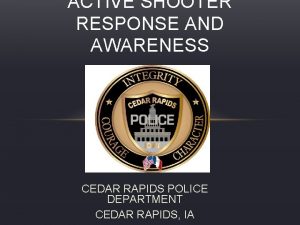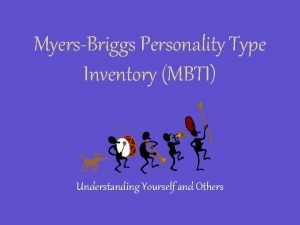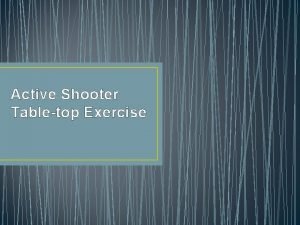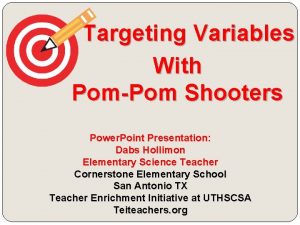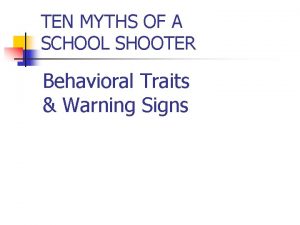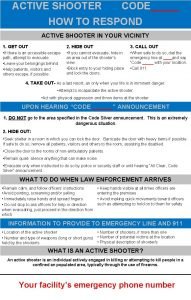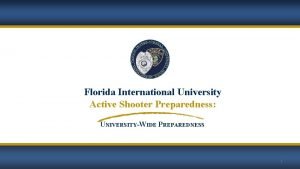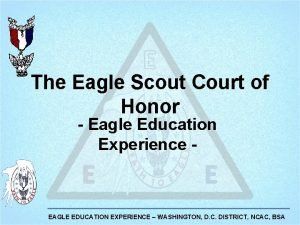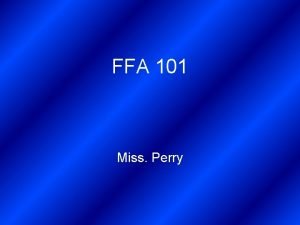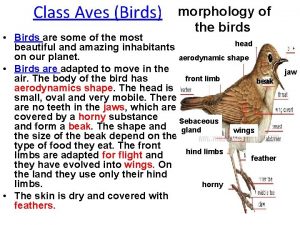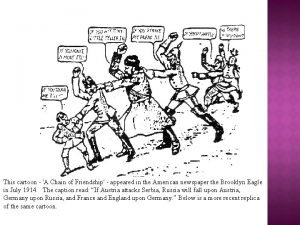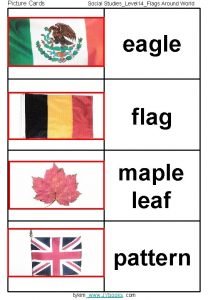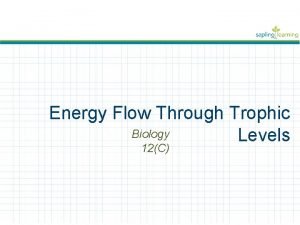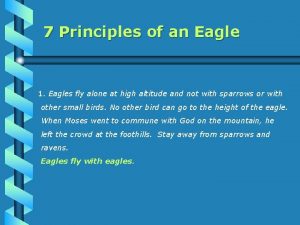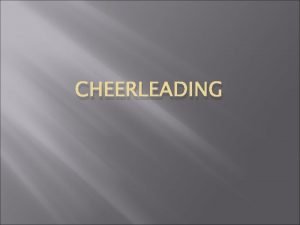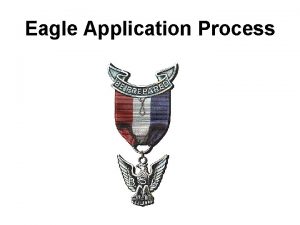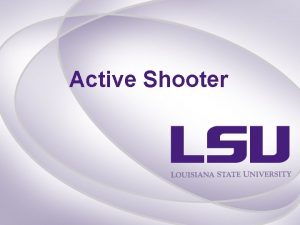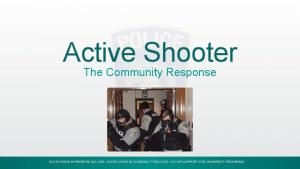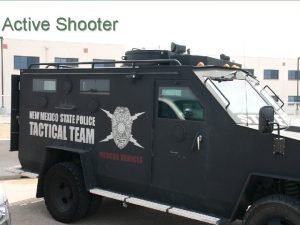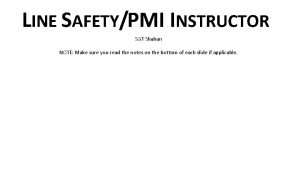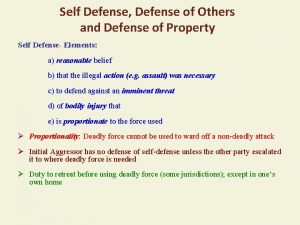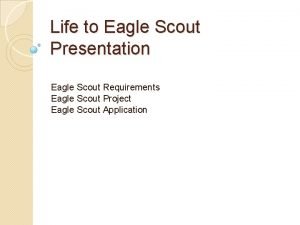THE SMART SHOOTER James Shahan President Eagle Defense





































































































- Slides: 101

THE SMART SHOOTER James Shahan President, Eagle Defense and Security Training. NOTE: Make sure you read the notes on the bottom of each slide if applicable.

PURPOSE The intent of this class is not to explain the fundamentals of shooting. You should know that by know. This slide show will explain to you the purpose of zeroing a rifle as well as how to read and interpret your shots on a Zero target as well as how to use your Zero target to collect data. You will also learn a strategy for shooting the ALT-C 25 m rifle qual. You will also learn about pistol shot group analysis. This information is valuable to you as both a shooter and a range safety. I suggest you use what you learn and pass it on to a shooter the next time you’re a line safety and keep the learning constant. This is also intended to make you a better range safety as far as being able to read shot groups and recommend adjustments and corrections.

POINT OF AIM WHAT YOU’RE AIMING AT SUCH AS CENTER MASS OR THE HEAD.

POINT OF IMPACT WHERE YOUR SHOTS ARE HITTING. BULLET HOLES ARE ALSO CALLED “IMPACTS. ” IF YOU’RE AIMING CENTER MASS AND YOUR HITTING CENTER MASS THEN BOTH YOUR POINT OF AIM AND POINT OF IMPACT ARE CENTER MASS. IF YOU’RE AIMING CENTER MASS AND HITTING THE HEAD THEN YOUR POINT OF AIM IS CENTER MASS AND YOUR POINT OF IMPACT IS THE HEAD.

MECHANICAL ZERO PURPOSE: Restores rifle sights back to “factory settings” by essentially erasing or “flushing” the current adjustments on it.

ZEROING PURPOSE: THE PROCESS OF FINDING THE FINE TUNE ADJUSTMENTS TO FIT YOUR EYESL. IKE GETTING A PAIR OF PRESCRIPTION LENSES. ZEROING A RIFLE MEANS SETTING IT AIM AND IMPACT CENTER MASS AT WHAT EVER DISTANCE IT’S SET TO. A 700 YARD ZERO MEANS YOU CAN AIM AND HIT CENTER MASS AT 700 YARDS

BZO PURPOSE: Battlesight Zero. Your personal ZERO settings to get it to shoot whatever the distance it’s set for. Typically 25/300 meters. AKA the sum of adjustments.

MECHANICAL ZERO Front sight: Base of front sight post must be flush front sight assembly. Front sight POST Base of front sight post Front sight assembly Think of it like this: If a little Leprechaun were to walk across your front sight assembly, you don’t want him to fall in the front sight post pit and get hurt! He needs you to make a level bridge so he can walk across safely.

MECHANICAL ZERO Front sight: Base of front sight post must be flush front sight assembly. Base of front sight is ABOVE Base of assembly. It’s too high!! Waaay too high. Front sight looks too low. Might be a click too high.

MECHANICAL ZERO PURPOSE: Back sight: Turn all the way to one side. Now turn all the way to the other and count the clicks. Divide clicks in half (as much as possible) and that should perfectly center your back sight. Sometimes around 85 clicks total and centered on 43 rd. If you have an M-16, set rear elevation to 8/3. M-4 is 6/3.

Whenever you draw your rifle for live fire, you should ALWAYS mechanical zero your rifle and add your personal adjustments because you never know who’s been messing with your rifle. It could have been loaned to another unit, someone could have dropped it in transport, or someone may just feel like being evil and messing everyone’s sights up.

WAYS TO ZERO

WAYS TO ZERO Standard basic training center mass: Point of Aim (POA): Center mass Point of Impact (POI): Center mass Advantage: Point of aim IS point of impact at 25/300 meters. Disadvantage: Center of mass placement from first group/shot isn’t typically the same center of mass placement as following since placing the front sight on an EXACT center of mass EACH shot is almost impossible. F R O N T S I G H T Impacts/bullet holes.

Adjusted POA/POI (high): Point of aim is HIGHER then point of impact. WAYS TO ZERO POA: Shoulders. POI: Center mass. Advantage: Can be easier to get a consistent aiming point by aligning front sight post with top of shoulders as opposed to trying to find center of mass each time. Similar to lollipop sight picture. Disadvantage: You have to remember that your point of aim is NOT your point of impact when you shoot qual. When doing this, you aim high and adjust low so that shots are still center mass. You can also keep your point of aim and impact the same and use this to get a good grouping in the head/neck area and then just aim center mass for your 5 shot zero group. Basically, aim at the head and adjust to the head, then just aim center mass. The only thing we’re really talking about with this is changing your reference point to get the same result.

Adjusted POA/POI (low): Point of aim is LOWER then point of impact. POA: Bottom of target. POI: Center mass. Advantage: Can be easier to get a consistent aiming point by aligning front sight post with bottom of target. Can be the easiest reference point. Disadvantage: You have to remember that your point of aim is NOT your point of impact when you shoot qual. When doing this, you aim low and adjust high so that shots are still center mass. WAYS TO ZERO

Hard line zero: POA: is hard lines of zero target and not target silhouette. POI: Corner of lines, Advantage: Since perfect center of mass is almost impossible every time which throws you off slightly each shot, placing front sight on hard intersecting lines can give you a better point of reference for front sight placement. Disadvantage: -RSO may think you’re a horrible shot and look at you crazy. -Will take longer to zero because first you have to get your group ZERO’d then you have to place 5 center mass to get off range. WAYS TO ZERO

Getting a good ZERO is the building block for distance rifle shooting which is why I try to teach it in as much detail as I can without going too crazy. Stick with regular center mass zero until you start getting more experienced with your rifle. The only thing an adjusted point of aim can give you is a slightly more precision grouping because you’re getting a more precise, consistent reference point which is something you don’t really need out to 300 meters. The difference is barely noticeable inside 300 meters and shooter error is going to have more of an impact then anything.

This is the minimum 5 shot standard to be considered properly ZERO’d. No where in Army Rifle FM does it state shots must be consistent however range OIC/ policy can implement this. 5 SHOT STANDARD

5 SHOT STANDARD? Find the good. Find the bad. Although there are 4 shots in the center and one side red shot breaking the line, this is not ZERO’d. Line breaks only count for qual. Plus side, except for the flyers this is a good group.

5 SHOT STANDARD? Find the good. Find the bad. It’s good. Notice how that red bottom left round is significantly inside the circle? The top left blue shot would not count as it barely touches the line and is outside the circle.

Find the good. Find the bad. It’s good. Is there cause for concern with that top right blue shot? Yes, absolutely but for zero’ing purposes this is fine plus take into consideration that all other shots are VERY tight and almost perfectly center mass so it could just be a fluke or they pulled the trigger too soon from nerves. 5 SHOT STANDARD?

5 SHOT STANDARD? Find the good. Find the bad. It’s good

SHOT GROUP ANALYSIS PURPOSE: DETERMINE IF WE NEED TO ADJUST THE WEAPON OR SHOOTER. QUESTIONS TO ASK A SHOOTER: WHERE WERE YOU AIMING DID YOU CHANGE AIMING POINT? HOW DID THE SHOTS FEEL? -SOMETIMES A SHOOTER CAN TELL EXACTLY WHAT HAPPENED ON A SHOT. DID YOU FLUSH YOUR ZERO BEFORE YOU CAME OUT?

SHOT GROUP ANALYSIS QUESTIONS TO ASK A YOURSELF WHEN DIAGNOSING GROUPS: How do they usually group? Poorly? Expert? If you’re looking at second or more group, are they still consistent with prior shots? How extreme are the issues? Is it slight trigger squeeze or profound? Is it the weapon or the shooter? – Weapon is characterized by consistent tight groups that just aren’t on center mass. Shooter is characterized usually by shot group size inconsistency, or large groups or if it looks like you can specifically identify which fundamental they need to work on. You CAN have issues with both weapon and shooter. NOTE: When we’re talking about “weapon” we mean the ZERO of that weapon. Typically, you make adjustments based off the center of the group. Always give shooters positive feedback without lying no matter what.

First group Second group Find the good. Find the bad. Weapon or shooter? Advice? Shot group is inconclusive. It is most likely the shooter since at least 2 shots are on the target and all shots are too far apart from each other. Adjust nothing. Shoot again then send to PMI if results are same. Always give positive feedback. At least all 6 shots are on the paper! This is usually a sight picture/alignment issue with anticipating recoil aka being afraid of the recoil.

Find the good. Find the bad. Weapon or shooter? Advice? Breathing is inconsistent. Most likely not trigger squeeze unless it’s the WORST trigger squeeze EVER. Since the shots are in a close group and not far apart it can be safe to say the shooter has decent fundamentals. You COULD do one of two things: 1. Have them re-shoot. 2. Adjust 2 up, 9 right based on center of group. Tell shooter group is nice but we need to tweak it and adjust.

Find the good. Find the bad. Weapon or shooter? Advice? Group is nice. Now we’re going to push perfection. Trigger squeeze. Adjust nothing. Rifle and shooter are fine. Shoot again. Need 2 more shots for ZERO. Notice one shot is perfectly center mass. So why aren’t they giving us the other two in that spot?

Find the good. Find the bad. Weapon or shooter? Advice? PVT Snuffy Group 1. Shooter is fine, rifle needs adjustments. 7 or 8 left, 6 down based on center of group.

Find the good. Find the bad. PVT Snuffy Group 2. Now we’re on the money! Notice the shot that is perfect center mass? Weapon or shooter? Advice? Adjust nothing because the shooter can produce perfection. Needs 2 more shots and it’s ZERO.

Find the good. Find the bad. Weapon or shooter? Advice? PVT Snuffy Group 3. WTF really? Adjust nothing because shooter just gave us perfection. Trigger squeeze is the obvious issue but something bigger impacted all 3 shots. It’s most likely not the ZERO adjustments you just made because there’s too much of an extreme between the last group, the adjustments you made, and this group. Just have them re-shoot.

Find the good. Find the bad. Weapon or shooter? Advice? PVT Snuffy Group 4. Good. Get off my range. Something is steadily declining in the shooter and it is most likely mental because the blue and red groups are amazing. Remember, this is the smallest target for qual and isn’t shot that often so since all targets are bigger then this in qual, there SHOULDN’T be an issue with this Soldier getting a first time qualify.

Find the good. Find the bad. Weapon or shooter? Advice? BRO, DO YOU EVEN MECH ZERO? Possibly didn’t mechanical zero. Grouping is fine so it isn’t the shooter’s fundamentals. It’s the rifle we need to fix. 12 up, 6 right. A even a horrible shooter with a proper mechanical zero shouldn’t usually be more then 1 -3 squares away from the silhouette unless their mech zero is crazy.

Find the good. Find the bad. Weapon or shooter? Advice? Hard to say. Shooter DID place a good, almost perfect center mass shot however the other shots are so drastically farther away but are at least closely grouped. Adjust nothing. Shoot again. Not enough shooter data on target to really say.

Find the good. Find the bad. Hard to say. Shooter did place two good, almost perfect center mass shots however the other shot is so drastically farther away. Adjust nothing. Shoot again. Weapon or shooter? Advice? Not enough shooter data on target to really say. Usually, the one flyer is the first shot because shooter’s remember “OH! That’s not so bad!” and are used to the recoil.

PISTOL SHOT GROUPS For the most part, reading a pistol target is just like reading a zero target only the pistol fundamentals are easier to notice. IDEAL/GOAL LEVEL SHOT GROUPS: 0 -5 YARDS 5 -10 YARDS 10 -20 YARDS 20 -25 YARDS 26 -30 YARDS

10 SHOTS 2 HAND STANDING 25 METERS FIND GOOD/BAD ADVICE? From 25 meters, the group itself is nice but since they’re grouped low right, it’s safe to assume the shooter has a problem with anticipating recoil. Right handed shooters will usually jerk trigger so shots are farther left and vise versa. Hands typically curl inwards with trigger jerk. This is a mind issue. See the bit on recoil anticipation.

10 SHOTS 2 HAND STANDING 25 METERS FIND GOOD/BAD ADVICE? This is what you’d like to see at 25 m. This is actually better then EXPERT level.

10 SHOTS 2 HAND STANDING 5 METERS If we take that same group from the last slide and shift it center mass, it looks great except when you remember we’ve changed the distance to 5 meters. FIND GOOD/BAD From 5 meters a good pistol shooter should see shots inside the X ring. ADVICE? However, depending on the frequency of how often the shooter hits the range, this may be amazing. At 5 meters, I would say it’s everything. Since the shots are all over, it’s clearly a sight picture issue. That bottom left most shot tells me it could be an anticipation of recoil with a right handed shooter as right handed shooters usually jerk shots left. Shooter needs more QUALITY PMI and dry practice.

10 SHOTS 2 HAND STANDING 25 METERS FIND GOOD/BAD ADVICE? From 25 meters, this is pretty good. Pay attention to the two X shots and the one in the 10 ring. That tells us that the shooter DOES understand the pistol shooting basics OR they got lucky. We’ll go with good shots. The two bottom most shots (8 ring) can be the last two or first two shots since they’re so far from the rest but considering all 10 shots are in the 8 ring or closer at 25 meters, that’s pretty great. Have shooter take extra time and concentrate more but this is a good group considering most shots are in the 9 ring or better.

10 SHOTS 2 HAND STANDING 25 METERS FIND GOOD/BAD ADVICE? Amazing group at 25 meters but the shooter is having trigger squeeze issues which is why the shots are drastically left. Typically right handed shooters pull shots to the left and left handed shooters pull right. If we’re in a competition setting where points matter, I’d say just aim more to the right and then the jerked shots would be in the X and 9. For Army qual purposes, keep doing what you’re doing because you’re on the way to being an EXPERT.

10 SHOTS 2 HAND STANDING 25 METERS FIND GOOD/BAD ADVICE? This is a little bit of everything. Send them to PMI or have them do some dry firing with emphasis on sight picture and trigger control. Long story short they are afraid of the shots which is why they’re all over the place. Watch the shooters eyes and trigger finger when they shoot again. Some shooters close their eyes when they shoot and don’t realize it.

ZERO MATH: HOW TO MAKE AND RECORD ADJUSTMENTS

Assuming proper BZO and fundamentals are applied. What is the ZERO for this shooter? First group Second group Third Group Answer: UP 3, L 7 (5 -8 ok). Adjust from the center of the group.

Assuming a proper mech zero and fundamentals are applied…. IF: 1 ST ADJUSTMENT- UP 3, LEFT 7. 2 ND ADJUSTMENT- UP 1, RIGHT 2. WHY IS FINAL ZERO /BZO UP 4 AND LEFT 5? First group Second group Third group Total clicks up were 4 up. 7 L-2 R is 5 R. Think of ZERO math like adding negative and positive numbers. In a nut shell, this shooter can now pick up any M 16 A 2, mechanically zero is and then adjust 4 up and 5 left and be ready for war.

Up 3, left 5 Up 2, right 1 What is final ZERO for Down 7, left 6 PVT Snuffy? Up 8, right 1 Down 1, left 2 Each set of adjustments is a 3 round Down 4, right 5 group. So first they shot 3 and you made Up 1, left 1 3 U/5 L, then they shot another 3 and you did 2 U/R 1. Down, 3 left 3 This is 33 shots fired Up 3, right 1 (11 groups of 3 shots. ) Down 2, left 2 Up 1, right 1 Think of it like positive and negative numbers. Already what you can be sure of is the shooter and safety had no idea what to do because after a while they were just chasing shots and not seeing the need for a break and PMI for the shooter but for training purposes just go with it

What the last slide looks like on paper…. Up 3, left 5 Up 2, right 1 Down 7, left 6 Up 8, right 1 Down 1, left 2 Down 4, right 5 Etc…. First group Second group Third group Fourth group Fifth group Sixth group If you see something like this, the shooter is having some kind of critical fundamental error or is chasing groups or something is just wrong. Also line safety should have pulled them off or had them shot with no adjustments twice for consistency.

Up 3 Up 2 Down 7 Up 8 Down 1 Down 4 Up 1 Down 3 Up 3 Down 2 Up 1 Up 5 Up 6 Up 1 Down 5 Down 7 Final Up/Down ZERO Adjustment is Up 1 Down 2 Up 1 Next time we can save all those rounds and time just by making an adjustment of “Up 1. ”

Left 5 Right 1 Left 6 Right 1 Left 2 Right 5 Left 1 Left 3 Right 1 Left 2 Right 1 4 Left 9 Left 5 Left Final Left/Right ZERO Adjustment is 10 Left 3 Right 1 Left All this shooter has to do is pick up a rifle, flush it back to a mechanical ZERO and adjust 1 UP and 10 LEFT and it’s ZERO’d to that shooter (Don’t think about how insane 10 left is, just think ZERO math for this) Left 4 Left 1 0 Right 1

Assuming proper mech zero is applied. . . IF 1 ST ADJUSTMENT- DOWN 3, LEFT 7. 2 ND ADJUSTMENT- RESHOOT. 3 RD ADJUSTMENT- DOWN 1, RIGHT 2 4 TH ADJUSTMENT- RESHOOT 5 TH ADJUSTMENT- ZERO. WHAT IS FINAL ZERO? First group Second group Third group Fourth group Fifth Group 4 Down, Left 5 - Final Zero If you make a minor adjustment by a few clicks and when they reshoot the group is really extreme like the difference between the 3 rd and 4 th group, just have them reshoot because something isn’t right. Either the 3 rd group was a fluke or the 4 th is.

PVT Snuffy Assuming proper mech zero is applied. . . Let’s say when you see this Shooter’s group, you have this. You recommend 9 Right (just go with it) Next slide…. First group Second group Third group Fourth group Fifth Group

NOW you have the second group (yellow). What do you do? In theory, 9 clicks left with proper shooting fundamentals SHOULD have put them center mass BUT now we need to go back to the RIGHT 12 clicks? …wtf? ! Something isn’t right. If you ever see this, you can have them shoot this again and see if something changes OR back track by erasing whatever adjustments you made and shoot again. In this case you would go 9 clicks right which SHOULD put the group around where the blue one is. This is why writing down data on the zero target is SOOO important. PVT Snuffy First group Second group Third group Fourth group Fifth Group

Using your Zero target as a data sheet. Information/data gathering is useful in ANYTHING not just shooting. It also lets shooter’s keep a record of what they’ve done with their rifle. I like setting it in the top left corner and writing it like G 1 - (adjustments) G 2 - N/A (if no adjustments) After the shooter has a zero, have them take a picture of the target so they can keep it for the next time they come out. G 1 -9 L/2 D G 2 -1 D G 3 -N/A- ZERO PVT Snuffy First group Second group Third group Fourth group Fifth Group

IDEAL ZERO RANGE 1. Draw weapon and mech zero. 2. Hit zero range and record adjustments. Let’s say 2 D/3 R is your zero. 3. Qualify. 4. Months later you go to the range with that rifle again. 5. Mech zero, add 2 D/3 R. 6. Confirm that 2 D/3 R is still your zero and hit the qual range. 7. Otherwise adjust and record new settings. If you add 2 D/3 R and it’s now shooting consistently lower, all you do is come up 1 then your NEW zero is 1 D/3 R.

SHOOTING FUNDAMENTALS AND OTHER STUFF THAT HURTS/HELPS SHOTS Trigger Squeeze Breathing Position/Natural point of aim/comfort/stance Grip Sight picture = Alignment of front sight, back sight, eyes Anticipation of recoil Gear Strategy Fatigue

Grading. Count the hits. (see next slide)

Grading. Hit Count the hits. 7 out of 10. All they need to do is touch the black. That’s it. 300 m target is barely grazed in bottom left corner but it counts for qualification. Hit Hit Hit

Prone supported 150 R- 2 hits. 50 - 2 hits. Total of 4 hits out of 20. Rifle could be ZERO’d too low since shooter is making tight shot groups directly below center mass on all targets. Count the hits. Issue? Either have them aim higher or bring front sight post up 2 -3 and don’t miss. Weapon or shooter? Advice? Keep qualifying? Hit Shooter can STILL qualify marksmen if they don’t miss anymore shots since 4+10+10=Qualified 24.

Prone unsupported Hit Count the hits. Hit Issue? Weapon or shooter? Advice? Hit Hit Prone supported (blue)300 x 1, 200 x 1, 150 Lx 1, 150 Rx 2, 100 Cx 1, 50 x 3= 9 Prone unsupported- 50 x 1= 1. Shooter is all over the place. It’s NOT the ZERO or the rifle since they shot a nice group on the right side 150 and 50. Shooter only has 9 graded hits. Even if they landed all 10 in the kneeling they would still only have 19 total and not qualified. Either use their remaining rounds as training rounds and have them shoot 3 -5 at a time in the prone at 300 or just let them go on with the rest of the qual course and send them to PMI.

STRATEGY 20 rounds prone supported RAINBOW 4 Starting with 300 lets you shoot the smallest target with most eye relief. OR Starting with 50 allows you to get the quick points and spend extra time on harder targets. Easy way to remember shots: Shoot the 50 or 300 and make pretty rainbows from left to right or right to left that way you don’t put too many in one target and not enough in another. RAINBOW 3 RAINBOW 2 RAINBOW 1

Strategy 10 rounds prone unsupported Starting with 300 lets you shoot the smallest target with most eye relief. Starting with 50 allows your to get the quick points and spend extra time on harder targets.

Strategy 10 rounds kneeling. Starting with 50 allows your to get the quick points and spend extra time on harder targets. Extra 2 shots by not trying 150 if you’re worried you didn’t hit 100’s or 50 and you DON’T need those 2 extra shots to qualify. EX: You already made MARKSMEN but you want SHARPSHOOTER X X

PMI SET UP RIFLE/PISTOL

A big part of shooting is mind set which is why Soldier’s do so well during dry fire PMI and so poorly with live ammo. If PMI is being done BEFORE live fire, advise against caffeinated drinks and anything that can cause dehydration and “jitters” especially for pistol since this will hurt your steady position. REMEMBER: A qualification course is a test of marksmanship fundamentals with the goal being to score the most points possible. Teach the course of fire and avoid talking about “combat shooting” when you’re teaching a test. If using the 25 Meter Alt C qualification for rifles, don’t talk about point of aim/point of impact at different distances. It’s not applicable since all shots are from 25 meters just at smaller targets.

RANGE PMI If you’re conducting PMI at a live fire range prior to live fire zero/qual, it should be about 30 -45 minutes. Remember, everyone coming through your PMI has had SOME kind of basic weapons training (uhh like in BASIC training) so everyone already knows how to load and operate. All you need to go is go over the basics using drills. Don’t have a power point about steady position, have everyone get into a steady position and make adjustments. Telling Soldier’s about how much a rifle weighs and its effective range is irreverent on a 25 meter ALT C range because none of that will directly make someone a better shooter. Keep the PMI relevant to whatever course of fire they’re going to shoot. If it isn’t going to help their ability to shot, it doesn’t need to be in the PMI.

FIRST! (If doing PMI AFTER shooter has failed to qualify) Have shooter remove all gear if possible so they can rest/cool down while they PMI. Go over gear placement and issues and work on fixing. Go over strategy for qual and various positions and variations of positions. Discussion prior to starting actual PMI/drills will allow shooter to have a longer break.

COMFORT Comfort is important because it helps in follow up shots and keeping a steady position over time. For the most part, show a shooter everything and let them decide what works for them. There IS a different between comfort and complacency. If someone is holding a pistol in a manner that just doesn’t look right BUT they say it’s comfortable and it’s the way they’ve always shot AND they’re doing terrible then it’s time to change and break bad habits. If something isn’t comfortable BUT it’s producing better results on target, try and encourage a shooter to go with what’s producing better shots.

COMMON GEAR COMPLAINTS ACH GETS IN THE WAY OF VISION: -Have shooter tighter the straps so it sits higher or have shooters push ACH back farther while in the prone. EYE PRO FOGS UPS/TOO HARD TO SEE: -Clear lenses. -Ensure there is enough air circulation with eye pro and eye pro isn’t stuck to the face causing moisture from heat. PRONE NOT COMFORTABLE: -Look at body armor set up and see if any gear sticks out too far. -Empty pockets and remove pistol and holster if allowed. -Detach Camel Back/hydration from back of body armor. HAVING PROBLEMS KEEPING RIFLE STEADY IN PRONE: -Remove lights and accessories. -Talking about using shooting block if available. PISTOLS: How is their holster positioned? Is it too low? (for leg holsters) Too far forward or backward on waist? “The first shot is too hard!” poor trigger control.

PMI DRILLS RIFLE/PISTOL

Can be done before or after live fire. Set up a very small target (no more bigger then a zero target, no smaller then a quarter: ü Zero target, coin, draw a small shape or place colored tape on vehicle. ü Contrasting target colors to front sight sometimes help with sight picture. (don’t use black) ü Watch shooter up close from the side like grading push ups. If coaching on line, don’t worry about where shots are being placed, worry about how their being fired. ü Small targets usually force shooter to take more time and concentrate. NATURAL POINT OF AIM: Have shooter get in prone and prepare to fire. Shooter closes eyes, takes 3 deep, relaxed, slow breaths, opens eyes. Target shouldn’t have moved. If target has moved, shooter needs to adjust positioning.

Dry fire prone drills. Place a spent case on the muzzle beak and force the shooter to slow down and concentrate. Can also be done with a pencil/pen placed in the barrel and place a dime on it. Fire 10 consecutive dry shots. Do this with all positions. Forces shooter to slow down and concentrate. If your limited on supplies, you COULD place a quarter on the front sight. It typically won’t fall with bad trigger control but it WILL force shooter’s to concentrate which typically produces good trigger control anyway.

TRIGGER CONTROL: Pull and hold trigger like a functions check. While holding trigger to the rear, shooter charges rifle and gets back into prone then releases trigger for reset. After trigger is reset, shooter keeps finger on trigger and shoots again. Explain trigger control is like having a piece of paper between the trigger and trigger finger and the shooter doesn’t want that paper to fall. FOLLOW UP SHOTS: Teach shooter to take 2 -3 shots, open and blink eyes, take a deep relaxed breath and reengage. TIME MANAGEMENT: Have shooter get in positions for actual time of course of fire to familiarize better with time management. No more then 6 seconds per shot for rifle.

RECOIL ANTICIPATION: Focus on front sight. Put all mental attention on font sight placement while slowly pulling trigger. Have shooters tell themselves the gun is empty. Shooters must convince themselves that they are still doing dry fire PMI. PISTOL TRIGGER CONTROL: Ask who knows how to drive a manual transmission. Compare trigger control like driving a manual; shooter must take up the dead space in the trigger before it comes to the point where the shot is ready to be fired. Have shooters take up a two hand standing position on target and slowly pull trigger all the to the rear until it comes to the point where the hammer is about to drop, then have them SLOWLY ride trigger forward just before the hammer is all the way forward. This will also help with the first shot from double action. This will also start to build hand strength.

BAD SHOOTING STANCES Typically, the most common stance issue is shooters lean back too much because they let the recoil dictate their body and don’t adjust. Notice how all 3 pictures have the shooter leaning back too much.

GOOD SHOOTING STANCES ü Good, balanced foot placement. ü Good slight bend in knees. ü Arms have good extension but aren’t locked out. ü Good arm extension.

GOOD SHOOTING GRIPS A good grip should: 1. Cover as much of both sides of the grip as possible. 2. Comfortably rest the thumbs. 3. Balance the gun in the hands and assist in keeping a steady platform. A LOT of shooters hold pistols too low And you see a noticeable gap between hand gun. The picture on the right is how a good grip should look. Great article on pistol grip http: //www. examiner. com/list/the-proper-grip-for-shooting-an-autoloading-pistol this is where I got the pictures.

GOOD SHOOTING GRIPS This is one way to have thumbs. It’s fine. Thumbs are sticking out and slightly away from the pistol. This isn’t ideal but if it works for the shooter and it makes a good group leave it be. This is another way to have thumbs. It’s fine. Thumbs are crossed. I’ve seen a lot of shooters place their support hand index finger in front of the trigger guard. I don’t understand this but there’s nothing wrong with it. I will say I’ve never seen a national shooting champion shoot that way but to each their own if it works.

BAD SHOOTING GRIPS Yes. I have seen these on the range. “Cup and saucer. ” This is only being supported by about one and a half hands instead of two hands.

PISTOL TRIGGER “TOO HARD? ” THINK YOU HAVE TOO WEAK OF HANDS? TORI NONAKA AT AGE 14 (2010) -MULTIPLE STATE LADIES/YOUTH PISTOL SHOOTING CHAMP -JUNIOR NATIONAL CHAMP -USPSA NATIONAL PRODUCTION (SERVICE GUN) LADIES CHAMP -USPSA VIRGINIA AND MARYLAND LADIES PRODUCTION CHAMP 15 (2011) -MADE GLOCK SHOOTING TEAM -USPSA VIRGINIA AND MARYLAND LADIES PRODUCTION CHAMP 18 (2013) YOUNGEST USPSA NATIONAL CHAMP LESS COMPLAINING, MORE TRAINING!

TIME TO GROW UP…. . TID BITS OF KNOWLEDGE M 16 A 2 zeroing target squares are. 96 centimeter in size. M 4 zeroing target squares are 1. 3 centimeters in size.

5. 56 NATO TRAJECTORY WITH A STANDARDM 4 RIFLE UNDER IDEAL CONDITIONS With a 25 Meter Zero Bullet rise or fall at…. 25 meters: 0 (level) 50 meters: +2 in 100 meters: +5 in 150 meters: +6 in 200 meters: +7 in 250 meters: +4 in 300 meters: Level 350 meters: -8 in 400 meters: -19 in 500 yards: -43 in +/For every 100 yards, drop rate almost doubles. The maximum effective range for the M 4 rifle on a point target is 500 meters/646 yards. M 855 drop during 25 -meter zeroing (M 4 read elevation knob handle at 6/3). Remember-“Aim low at 200 and below. ”

5. 56 NATO TRAJECTORY WITH A STANDARDM 4 RIFLE UNDER IDEAL CONDITIONS 25 Meter Zero 25 meters: 0 (level) 50 meters: +2 in 100 meters: +5 in 150 meters: +6 in 200 meters: +7 in 250 meters: +4 in 300 meters: Level 350 meters: -8 in 400 meters: -19 in 500 yards: -43 in +/For every 100 yards, drop rate almost doubles. The maximum effective range for the M 4 rifle on a point target is 500 meters/646 yards.

MOA’S On the M 4 front sight post, one click will move the bullet 1. 5 inches at 100 yards, 3 inches at 200 yards, 4. 5 inches at 300 yards, etc. Formula- 1. 5 x yards/meters distances without zero’s. IE- 1. 5 MOAx 3 (300 yards/meters)=4. 5 inches.

BACK UP SIGHTS Effective when firing 600 meters away Place rear sight on 300 meter mark with M 4’s and white line for M 16’s. Generally, if a man-sized target is ½ of the width of the front sightpost, the target is approximately 300 meters away. If the target is ¼ of the width of the front sightpost, the target is approximately 600 meters away.

ACOG The designated impact zone is 1 centimeter down from the center of mass of the 300 -meter silhouette on the 25 -meter zeroing target. The outside legs of the chevron reticle in the ACOG correspond to 19 inches (average width of a man's shoulders) at 300 meters. The widths of the horizontal hash marks on the BDC reticles in all ACOG scopes correspond to the width of a. 5 meter (19 inches) silhouette (man-size) at that range. Good reference point

ZEROING ACOG At 25 meters, 16 clicks move the bullet 1 inch (two M 4 zero target squares) or 8 clicks per square on M 4 zero target. To ensure a consistent zero, tap the scope with the palm of your hand to stabilize the adjustment mechanism after an adjustment has been made, and then fire a three-shot group on the target. For 25 meters, use the tip of the 300 -meter post as POA/POI.

ZEROING ACOG Impacts 10 mil Mil’s and MOA are like yards and meters 1 mil = 3. 438 moa or. 29 mil = 1 moa 10 mil 34. 38 MOA WTF DOES THAT MEAN!? If you’re aiming at 100 meters and your shots (yellow dots) are hitting where the first line is, you need to click roughly 34 clicks left.

CCO Designed for the two eyes open method of sighting. The dot follows the horizontal and vertical movement of the firer’s eye, while remaining fixed on the target. No centering or focusing is required. Mount the CCO to the front of the receiver rail or to the top ARS, as preferred.

ZEROING CCO (1) Starting from center of mass the 25 -meter zeroing target, count down 1½ squares or 1. 4 centimeters. This is now the point of impact when zeroing the M 68 CCO. (2) Continue to aim at the center of mass and make adjustments to the M 68 CCO so that the rounds impact in the secondary 4 x 4 centimeter circular box, 1½ squares or 1. 4 centimeters down from the point of aim. For windage and elevation, two clicks equal 1 centimeter (roughly 1 M 4 zero target square) at 25 meters.

WHAT DISTANCES DO OTHER FACTORS MATTER? (ABOUT 200+ YARDS) After about 100 yards you will need more then good shooting fundamentals to achieve the most accurate shots possible. Rifle shooting fundamentals are just the, fundamentals. They are the building blocks of shooting.

STANDARD M-4 ROUND M 855 cartridge – 5. 56 -mm, ball Green tip The M 855 cartridge is used in the M 16 A 2/3/4 and in M 4 -series weapons. The M 855 cartridge has a 62 -GRAIN, gilded metal-jacketed, lead alloy core bullet with a steel penetrator. The primer and case are waterproof. This round is also linked and used in the M 249. NOTE: This ammunition should not be used in the M 16 A 1 except under emergency conditions, and only at targets less than 90 meters away. The twist of the M 16 A 1 rifling is not sufficient to stabilize the length of the round's projectile.

HOLD’S VS ADJUSTMENTS HOLD: Kentucky windage. You adjust your physical point of aim to achieve center mass shots. IE Aiming at the head to impact center mass. ADJUSTMENTS: Modifying your ZERO/back sight/front sight to account for distance and wind. Point of aim is STILL center mass. Hold’s are used when there is not enough time to make adjustments or when the shooter doesn’t know how to calculate adjustments. EX- At 400 yards, you forget how many clicks you need to make to still aim center mass so you just aim at the top of the head.

WIND § The clock system is used to indicate wind direction and value. § Winds that blow from the left (9 o’clock) or right (3 o’clock) are called FULL VALUE winds because they have the most effect on the bullet. § Winds that blow from an oblique (1 -2, 4 -5, 7 -8, 10 -11 o’clock) are called HALF VALUE winds as they have half the effect of a full value wind. § Winds that blow from 12 o’clock or 6 o’clock are referred to as NO VALUE winds as they have virtually no effect on the flight of the bullet.

WIND FORMULA (1) Windage. To compute the distance one click of windage moves the strike of the bullet at a range of 300 meters, divide 300 meters by 25 meters and multiply by. 33 centimeters. D = 300 m ÷ 25 m = 12, 12 x. 33 = 3. 96 centimeters (round this up to 4. 0). One click of windage moves the strike of the bullet 4 centimeters at 300 meters.

ACOG WIND FORMULA

WHY 100 YARD ZERO? Many distance shooters use the 100 yard zero as a baseline for distance shooting. The 25/300 m ZERO isn’t better then the 100 yard, it’s just a different way to achieve the same result.

EFFECTS OF TEMPERATURE/COLD VS HOT BORE If you zero your rifle at 8 am and it’s 50/60 degrees outside and you either shoot all day and/or wait until the afternoon where it’s 80/90+ degrees outside, the metal that makes up your barrel has heated and softened and the zero you had in the morning is not going to impact the same way as when your barrel is hot. This doesn’t become a factor until you start shooting 1000 yards or 500+ yards and are shooting for basically absolute precision.

DATA COLLECTION Data collection is important because if you shoot all day one, and when you go to shoot on day 5 the environmental/atmospheric conditions are completely different, you can look at your data sheet to see when was the last time you fired under the same or similar conditions as day 5 and get a better understanding of what to expect. Let’s say you’re shooting a distance rifle competition in Alaska in December. When you zero your rifle at 300 meters (not 25), it’s 10* outside and your competition is out to 400 meters. You write down your temperature and wind. A month later you shoot that same competition in New Mexico in July. Is it safe to safe that if you use the Alaska data in New Mexico, you won’t have the same exact precise data or impacts? Remember, for this rifle competition you want all your shots as close to the X ring as possible to precision is crazy important.


CHEAT SHEET AKA DATA ON PERSONAL EQUIPMENT (DOPE) CARD Dope cards are small yet important notes that are kept on the rifle such as your zero at certain distances or bullet drop or both. It’s a cheat sheet for your data to help you remember and adjust on the fly.


GOOD INFO TO KNOW ELEVATION BUI SIGHTS- 300 FORM 4, WHITE LINE FORM 16 M 4 CARRY HANDLE ELEVATION KNOB SETTING- 6/3 M 4 FRONT SIGHT MOA- 1. 5 M 4 ELEVATION KNOB MOA-. 75 M 4 WINDAGE KNOB MOA-. 75 M 16 A 2 CARRY HANDLE ELEVATION KNOB SETTING-8/3 M 16 A 2 FRONT SIGHT MOA- 1. 25 M 16 A 2 ELEVATION KNOB MOA- 1 M 16 A 2 WINDAGE KNOB MOA-. 5 1 MOA IS 1 CLICK AT 100 YARDS. 1. 5 MOAX 3 (300 YARDS/METERS)=MOVES IMPACT 4. 5 INCHES.
 25/300 yard zero target
25/300 yard zero target Ducks unlimited checks
Ducks unlimited checks Nonspecific defense mechanisms
Nonspecific defense mechanisms Smart two men are
Smart two men are Kim ung-yong
Kim ung-yong It is not how smart you are it's how you are smart
It is not how smart you are it's how you are smart Street smart vs book smart quotes
Street smart vs book smart quotes Everfi future smart ways to pay answers
Everfi future smart ways to pay answers One smart man he felt smart
One smart man he felt smart Street knowledge vs book knowledge
Street knowledge vs book knowledge It's not how smart you are
It's not how smart you are Clay lawson and russell odom
Clay lawson and russell odom James clayton lawson
James clayton lawson Seung-hui cho
Seung-hui cho Don ebert
Don ebert Shooting game maker
Shooting game maker Nnn shooter
Nnn shooter Unity top down shooter tutorial
Unity top down shooter tutorial Run hide fight
Run hide fight First person shooter ideology
First person shooter ideology Peter odighizuwa
Peter odighizuwa Report sharp shooter
Report sharp shooter Active shooter tabletop exercise
Active shooter tabletop exercise A survival mindset is comprised of which three components?
A survival mindset is comprised of which three components? Bwh healthstream
Bwh healthstream Active shooter healthstream
Active shooter healthstream Vttx
Vttx Extreme response gap
Extreme response gap Is907
Is907 Cedar rapids active shooter
Cedar rapids active shooter Nf idealist
Nf idealist Active shooter tabletop exercise
Active shooter tabletop exercise Pom pom shooter
Pom pom shooter School shooter traits
School shooter traits Active shooter code
Active shooter code Shooting at fiu
Shooting at fiu Voi kéo gỗ như thế nào
Voi kéo gỗ như thế nào Thiếu nhi thế giới liên hoan
Thiếu nhi thế giới liên hoan điện thế nghỉ
điện thế nghỉ Một số thể thơ truyền thống
Một số thể thơ truyền thống Thế nào là hệ số cao nhất
Thế nào là hệ số cao nhất Trời xanh đây là của chúng ta thể thơ
Trời xanh đây là của chúng ta thể thơ Lp html
Lp html Bảng số nguyên tố
Bảng số nguyên tố đặc điểm cơ thể của người tối cổ
đặc điểm cơ thể của người tối cổ Fecboak
Fecboak Các châu lục và đại dương trên thế giới
Các châu lục và đại dương trên thế giới Tư thế worm breton là gì
Tư thế worm breton là gì ưu thế lai là gì
ưu thế lai là gì Hệ hô hấp
Hệ hô hấp Tư thế ngồi viết
Tư thế ngồi viết Cái miệng bé xinh thế chỉ nói điều hay thôi
Cái miệng bé xinh thế chỉ nói điều hay thôi Mật thư tọa độ 5x5
Mật thư tọa độ 5x5 Bổ thể
Bổ thể Tư thế ngồi viết
Tư thế ngồi viết Ví dụ giọng cùng tên
Ví dụ giọng cùng tên Thẻ vin
Thẻ vin Thể thơ truyền thống
Thể thơ truyền thống Chúa sống lại
Chúa sống lại Các châu lục và đại dương trên thế giới
Các châu lục và đại dương trên thế giới Hổ sinh sản vào mùa nào
Hổ sinh sản vào mùa nào Từ ngữ thể hiện lòng nhân hậu
Từ ngữ thể hiện lòng nhân hậu Diễn thế sinh thái là
Diễn thế sinh thái là Vẽ hình chiếu vuông góc của vật thể sau
Vẽ hình chiếu vuông góc của vật thể sau 101012 bằng
101012 bằng Tỉ lệ cơ thể trẻ em
Tỉ lệ cơ thể trẻ em Lời thề hippocrates
Lời thề hippocrates đại từ thay thế
đại từ thay thế Quá trình desamine hóa có thể tạo ra
Quá trình desamine hóa có thể tạo ra Môn thể thao bắt đầu bằng chữ f
Môn thể thao bắt đầu bằng chữ f Công thức tính độ biến thiên đông lượng
Công thức tính độ biến thiên đông lượng Hát kết hợp bộ gõ cơ thể
Hát kết hợp bộ gõ cơ thể Sự nuôi và dạy con của hươu
Sự nuôi và dạy con của hươu Thế nào là mạng điện lắp đặt kiểu nổi
Thế nào là mạng điện lắp đặt kiểu nổi Dạng đột biến một nhiễm là
Dạng đột biến một nhiễm là Biện pháp chống mỏi cơ
Biện pháp chống mỏi cơ Vẽ hình chiếu đứng bằng cạnh của vật thể
Vẽ hình chiếu đứng bằng cạnh của vật thể độ dài liên kết
độ dài liên kết Eagle
Eagle Eagle scout pledge
Eagle scout pledge What does the eagle on the ffa emblem mean
What does the eagle on the ffa emblem mean Birds
Birds Eagle product inspection headquarters
Eagle product inspection headquarters Pcb designprozess
Pcb designprozess Proteus xrf
Proteus xrf What does the chain of friendship cartoon mean
What does the chain of friendship cartoon mean Eagle cabs
Eagle cabs Fanatic eagle 126
Fanatic eagle 126 Golden eagle pride scout
Golden eagle pride scout Why did eagles almost go extinct
Why did eagles almost go extinct Eagle images
Eagle images Trophic level definition biology
Trophic level definition biology Listed below
Listed below Seven principles of eagle
Seven principles of eagle Education quality and accountability office
Education quality and accountability office Eagle eye anatomy
Eagle eye anatomy Harpy eagle eating berries
Harpy eagle eating berries Life span of eagle
Life span of eagle Black eagle logistics
Black eagle logistics Basic cheer jumps
Basic cheer jumps Bald eagle kingdom
Bald eagle kingdom Mbao pension plan
Mbao pension plan
